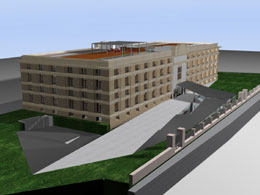STUDENTS PROJECTS
2009

08 May, 2011
Transformation of the warehouse of tobacco Papapetrou in an Archeological museum of Aitoloakarnanias and cultural centre of Agrinio
Papapetrou warehouse of tobacco is a well preserved building in the area as well as a very popular structure thanks to its unique technique.
Student: Pavlou Elpiniki
Supervisors : Adamakis Konstantinos , Gavrilou Evelin
October 2008

The building is imposing and is characterized by symmetry in the organisation of aspect and ground plan, axial access, importance of the central entry and sovereignty of facade, clarity of the volume of the building. The chronology that it is constructed, is approximately in 1932 and the architect of the building was Spyros Papapetros.

It used to be in the centre of the everyday life of the city in regard to the activities of tobacco, which were closely related to this unique building and its design. Today Agrinio city suffers also from the lack of a modern Museum as well as the lack of an infrastructure where the former could be sheltered, while many discoveries are reserved in inadequate places. In an attempt to solve the aforementioned issue, the need for a new Museum along with a cultural centre becomes of high significance. Papapetrou warehouse of tobacco.

In the old building our initial confrontation is that the space of the underground floor, that has 3.60 m height is suitable in order to be covered needs of being first importance - public spaces. The same happens in the ground floor and second (b) floor, that have 3.10 m height. Moreover it should be marked that there is internal communication (with an opening in the floor in the first (a) and third (c) floor.

The first (a) floor has 2.20 m height, so that it can be used only as secondary space ex. stocking spaces. The third (c) floor (the last one) has 2.20 height. However because the plate of roof is destroyed it can be removed and shift itself more tally so that the height of the floor grows. Moreover some holes in the roof are created, that will be closed with glass, in the same position of the plates of the floors.

Consequently the space of underground where there is enough light will cover the needs of bookshop, laboratories, projection video, with optional choice of opening of metallic the panels.In the ground floor and in the first (a) floor are located more public spaces (offices, spaces of cafeteria, temporary exhibitions, library) and in the second (b) and third (c) floor are located the spaces of permanent exhibitions.

For the needs moreover of cultural centre and for the creation of the amphitheatres is appropriate the creation of new building. The new building will become a connection of past with the modern city and it will be like organisation of anarchist city of Agrinio. In this are located two amphitheatres, a room of discussions, toilets, cafeteria and secretary for information.

There is a course that leads to the old building and an other that leads to the new one. Moreover the new building is connected with two floor underground parking of 78 places and 1147 m2.

Greece is a country abundant with industrial buildings among which there are many historical warehouses of tobacco scattered in many cities all over the country, that do not attract attention to the same extent like in the past and many of those have been already forgotten and have already faded along with the semi-destroyed buildings. A city where this phenomenon is well prevailing is Agrinio.

In conclusion, the aim of this paper is to bring to the fore the significance of the warehouse of tobacco, its historical heritage along with invigorating the interest for this building again and at the end the construction of a Museum which will serve the city of Agrinio as well as the wider area, providing shelter to various founds and at the same time trying to invigorate this special structure in the city centre.
Related articles:
- UNDERGROUND MUSEUM IN PALIOURI DIMINIOU OF PHYSICAL DISCIPLINE AND BODY INCARCERATION ( 26 August, 2007 )
- Moderna Museet Malmö ( 10 May, 2010 )
- NEW PATRAS MUSEUM ( 12 October, 2009 )
- NATIONAL RESISTANCE MUSEUM AND MONUMENT TO ELECTRA APOSTOLOU IN NEON HERAKLEION, ATHENS ( 19 October, 2009 )
- Small mining museum and centre of environmental research in Itea. ( 17 July, 2010 )
- 3rd Prize for a Greek entry in an international architectural competition ( 20 September, 2010 )
- ATHENS COMICS MUSEUM at Gkazi ( 10 February, 2011 )
- Costume Culture Museum ( 10 February, 2011 )
- Stone Bridge Museum ( 18 September, 2012 )
- “Urban intervention network in Plato’s Academy_A Museum of the city of Athens proposal” ( 10 April, 2011 )
- Los Angeles Museum of the Holocaust ( 15 June, 2011 )
- Archaeological Museum of Arta ( 12 August, 2013 )
- "Earth Museum" ( 05 January, 2012 )
- Venetian Arsnals of Chania ( 24 January, 2012 )
- New Taipei City Museum of Art, Conceptual Design International Competition August 2011 ( 08 February, 2012 )
- Mining Museum in Serifos ( 15 February, 2012 )
- Riverside Clubhouse ( 10 March, 2012 )
- New Glasgow Riverside Museum of Transport ( 24 April, 2012 )
- Enzo Ferrari Museum ( 23 April, 2012 )
- Bunker 599 603 ( 06 May, 2012 )
- Heidelberg Castle’s new Visitor Center ( 24 May, 2012 )
- Grand Egyptian Museum in Cairo ( 22 January, 2013 )
- Guggenheim Museum in Helsinki ( 22 March, 2013 )
- Noesis. Interactive Museum ( 20 May, 2013 )
- Danish National Maritime Museum ( 28 November, 2013 )
- Redefining Leftovers ( 05 April, 2014 )
- Cultural center of Glyfada ( 23 February, 2014 )
- The rack railway museum at Vouraikos gorge ( 18 April, 2014 )
- Historical and Folklore Museum of Nikiti ( 17 February, 2017 )










